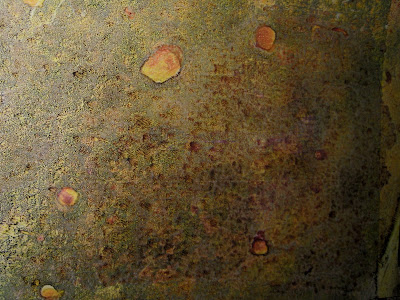 A few people have e-mailed me off-line to ask what the turp papers are that I've mentioned in a couple of posts that I've used in some of my artwork. I thought I had blogged about this a couple of years ago, but I can't find the post now.
A few people have e-mailed me off-line to ask what the turp papers are that I've mentioned in a couple of posts that I've used in some of my artwork. I thought I had blogged about this a couple of years ago, but I can't find the post now.Not sure where I first learned about this technique, but I think it was Sally Turlington. And I'm not sure if Sally actually used turpentine or if she used a product called CitraSolv. I couldn't readily find CitraSol when I wanted to make my turp papers, so I used turpentine. I think if I ever make these papers again, I'll try to find the CitraSolv because turpentine is REALLY STINKY and the smell stays FOREVER! Well, maybe not forever, but it stays for a really long time.
 I remember too that I didn't follow the instructions that I had read, so the technique I'm about to write is what I did, not necessarily what Sally or other people do to make their papers.
I remember too that I didn't follow the instructions that I had read, so the technique I'm about to write is what I did, not necessarily what Sally or other people do to make their papers. The first thing I did was go to my neighborhood Friends of the Library and purchased 3 large bags of old National Geographic magazines. Why NG magazines? Because they are clay-coated and I'm not sure what other magazines have that type of coating on the pages.
The first thing I did was go to my neighborhood Friends of the Library and purchased 3 large bags of old National Geographic magazines. Why NG magazines? Because they are clay-coated and I'm not sure what other magazines have that type of coating on the pages. Then I headed over to the Goodwill store and picked up a large metal roasting pan.
Then I headed over to the Goodwill store and picked up a large metal roasting pan.I got the turpentine at the hardware store.
 I tore each of the magazines at the spine into 3 or 4 parts to make them easier to work with.
I tore each of the magazines at the spine into 3 or 4 parts to make them easier to work with.With rubber gloves on, fill the roasting pan about 50% full of turpentine.
I started submerging the magazines into the turpentine, making sure that all of the pages were saturated. Might want to wear a mask when you do this, and please do this OUTSIDE - not in an enclosed garage like one of my students did last year. YIKES!

Once the papers were wet, I kind of "smooshed" the pages together to get some cool effects. Some pages turn out better than others. Beauty is in the eye of the beholder, right?
Tear out the pages you like and lay them out on some freezer paper to dry for a few days.
 When I use these papers (even 2 years later) they still smell of turpentine, but once I seal the artwork with a top coat (spray sealer, Diamond Glaze, decoupage medium, etc.) the papers no longer stink.
When I use these papers (even 2 years later) they still smell of turpentine, but once I seal the artwork with a top coat (spray sealer, Diamond Glaze, decoupage medium, etc.) the papers no longer stink.So there you go - Turp Paper!




5 comments:
Thanks so much. This inquiring mind really appreciates it. I love the pages you have showed. Sharon
FYI - CitraSolve stinks forever too. But a sort of nice stinky, if you like orange. Sitting outside in a box in the sun for 2 weeks didn't take all the stink out. I think the cut-off date for the Natl Geos is 2004 or earlier.
What an interesting post. I tell you Sherry, when I see Diamond Glaze I think of you. LOL!!
What a cool effect and technique Sherry! Thanks for sharing:)
Sherry...thanks for sharing how you make turp paper. Patty has directions for making it too. If you go to her website and click on Tuscan Rose and then tips and techniques. She is offering an altered book class that I'm taking is how I found out about her store. Her website is: http://ramblingrose.typepad.com/
Mary
Post a Comment